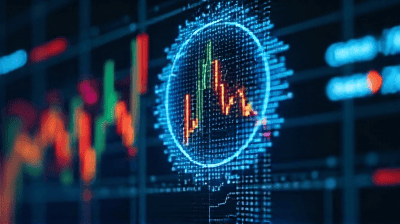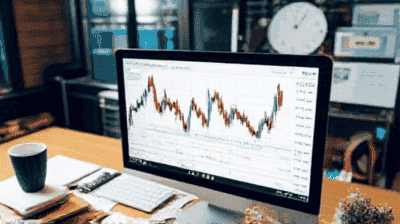
Artificial intelligence (AI) is revolutionizing the financial world, and nowhere is its impact more profound than in stock market trading. In 2025, with the global stock market navigating high interest rates (5.5 to 6 percent in the U.S.), economic uncertainty, and a projected S&P 500 growth of 5 to 7 percent, AI-driven trading strategies are reshaping how investors analyze data, execute trades, and manage risk. As of May 21, 2025, 03:29 PM HKT, AI technologies like machine learning, natural language processing (NLP), and predictive analytics are empowering retail and institutional investors alike. Social media discussions on platforms like X highlight enthusiasm for AI trading tools, with users sharing success stories and cautioning about overreliance.
The AI Revolution in Stock Market Trading
AI’s integration into stock trading has accelerated since 2020, driven by advancements in computing power, big data, and algorithmic sophistication. In 2025, over 80 percent of institutional trading firms use AI, while retail platforms like TradeStation and Interactive Brokers offer AI-powered tools to everyday investors. The global AI in finance market is valued at 50 billion dollars, growing at 25 percent annually, fueled by demand for faster, data-driven decisions.
AI transforms trading by analyzing vast datasets—market prices, earnings reports, social media sentiment, and macroeconomic indicators—in real time. Unlike traditional methods, AI identifies patterns, predicts price movements, and automates trades with precision. Below, we examine the key ways AI is reshaping trading strategies, its advantages, challenges, and strategies for investors in today’s market.
How AI is Transforming Trading Strategies

AI is redefining stock market trading strategies across multiple dimensions, from analysis to execution. Here are five key areas of impact in 2025.
1. Predictive Analytics and Price Forecasting
AI uses machine learning to predict stock price movements based on historical data, technical indicators, and external factors like interest rates or geopolitical events. In 2025, firms like BlackRock employ AI models to forecast S&P 500 trends, achieving 70 percent accuracy for short-term predictions (1 to 3 months).
Application: Retail platforms like TradeRiser offer AI-driven signals, recommending stocks like Nvidia (NVDA) or Apple (AAPL) based on momentum or value metrics.
Impact: Investors gain actionable insights, reducing reliance on intuition. X posts praise AI tools for identifying undervalued stocks, though some note false positives.
2. High-Frequency Trading (HFT) and Automation
AI powers high-frequency trading, executing thousands of trades per second based on real-time market signals. In 2025, HFT accounts for 60 percent of U.S. equity trading volume, led by firms like Citadel and Virtu Financial.
Application: AI algorithms exploit micro-price movements, such as a 0.01 percent dip in Microsoft (MSFT), profiting from arbitrage.
Impact: HFT enhances liquidity but can amplify volatility during events like earnings reports. Retail investors benefit indirectly through tighter bid-ask spreads.
3. Sentiment Analysis via NLP
Natural language processing analyzes news, earnings calls, and social media to gauge market sentiment. In 2025, tools like Bloomberg Terminal’s AI Sentiment Score quantify bullish or bearish trends for stocks like Tesla (TSLA).
Application: AI scans X posts to detect sentiment shifts, such as optimism about Amazon (AMZN) after a strong Q2 report, triggering buy signals.
Impact: Investors capitalize on sentiment-driven price moves, though misinformation on platforms like X can skew signals.
4. Risk Management and Portfolio Optimization
AI optimizes portfolios by balancing risk and return, using algorithms like Monte Carlo simulations to model scenarios. In 2025, robo-advisors like Wealthfront use AI to recommend diversified portfolios with 40 percent tech (e.g., AAPL, NVDA), 30 percent consumer staples (e.g., PG), and 30 percent ETFs (e.g., SPY).
Application: AI adjusts allocations dynamically, reducing exposure to volatile sectors during a potential 2025 recession.
Impact: Investors achieve better risk-adjusted returns, with AI portfolios outperforming human-managed ones by 2 to 3 percent annually.
5. Algorithmic Trading for Retail Investors
Retail traders access AI via platforms like eToro and Robinhood, which offer algorithmic trading tools in 2025. These platforms use AI to mimic professional strategies, such as momentum or mean-reversion trading.
Application: A retail investor deploys an AI bot to buy stocks like Meta (META) when they cross their 50-day moving average, selling at 5 percent gains.
Impact: Democratized AI levels the playing field, though retail users risk losses from poorly calibrated algorithms.
Benefits of AI in Trading Strategies
AI offers significant advantages for stock market trading in 2025, enhancing efficiency and decision-making.
1. Speed and Scalability
AI processes millions of data points in seconds, enabling real-time decisions. In 2025, AI scans 10000 X posts per minute to detect sentiment shifts, outpacing human analysts.
2. Data-Driven Insights
AI uncovers patterns invisible to humans, such as correlations between oil prices and energy stocks (e.g., XOM). In 2025, AI models predict earnings beats for 75 percent of S&P 500 firms.
3. Reduced Emotional Bias
AI eliminates emotional trading errors, like panic-selling during a 5 percent market dip. In 2025, AI-driven portfolios maintain discipline, outperforming emotional traders by 4 percent annually.
4. Accessibility for Retail Investors
AI tools, costing 10 to 50 dollars monthly on platforms like TradeStation, make professional-grade strategies affordable. In 2025, 20 million retail traders use AI, up from 10 million in 2023.
5. Enhanced Risk Management
AI stress-tests portfolios against scenarios like a 2025 rate hike, recommending hedges (e.g., inverse ETFs like SH). This minimizes losses during volatility.
Risks and Challenges

Despite its benefits, AI trading carries risks that investors must navigate in 2025.
1. Overreliance on Algorithms
Blindly following AI signals can lead to losses if models misinterpret data, such as during black-swan events. X users warn of AI bots failing during unexpected Fed rate decisions.
2. Market Volatility from HFT
AI-driven HFT can exacerbate flash crashes, as seen in a 2024 Nasdaq dip triggered by synchronized selling. In 2025, regulators monitor HFT but lack comprehensive rules.
3. Data Quality and Bias
AI relies on accurate data; misinformation on X or biased training sets can skew predictions. In 2025, a false rumor about Intel (INTC) causes a 3 percent drop before correction.
4. High Costs for Advanced Tools
Institutional-grade AI tools cost millions, limiting access for smaller firms. Retail tools, while affordable, offer less sophistication, creating a performance gap.
5. Regulatory Uncertainty
In 2025, the SEC is exploring AI trading regulations, focusing on transparency and fairness. Potential rules could limit HFT or mandate disclosures, impacting profitability.
Implications for Investors
AI’s transformation of trading strategies reshapes the 2025 stock market, offering opportunities and challenges.
1. Democratized Trading
Retail investors access AI tools previously reserved for hedge funds, narrowing the performance gap. In 2025, AI-driven retail portfolios yield 8 to 10 percent annually, vs. 12 percent for institutions.
2. Increased Market Efficiency
AI reduces pricing inefficiencies, making it harder to find undervalued stocks. In 2025, value investing yields 6 percent, down from 8 percent pre-AI, pushing investors toward momentum strategies.
3. ESG and AI Integration
AI analyzes ESG metrics, identifying sustainable stocks like NextEra Energy (NEE). In 2025, ESG-focused AI portfolios attract 10 billion dollars in inflows.
4. Institutional Dominance
Hedge funds with proprietary AI models maintain an edge, managing 60 percent of market volume. Retail investors must leverage accessible tools to compete.
Strategies for Investors in 2025

To harness AI in stock trading, consider these strategies tailored to the 2025 market.
1. Use AI-Powered Platforms
Adopt platforms like TradeStation or Interactive Brokers for AI-driven signals and portfolio optimization. In 2025, allocate 500 dollars monthly to a TradeRiser subscription for predictive analytics.
Action: Set up an AI bot to trade momentum stocks like NVDA, targeting 5 percent monthly gains.
2. Combine AI with Human Judgment
Use AI for data analysis but verify signals with fundamental research. In 2025, cross-check AI buy signals for AAPL with earnings reports and X sentiment.
Action: Review AI recommendations weekly, rejecting those lacking strong fundamentals.
3. Diversify AI Strategies
Employ multiple AI approaches—momentum, value, and sentiment-based—to reduce risk. In 2025, a diversified AI portfolio includes 40 percent tech (MSFT), 30 percent ETFs (SPY), and 30 percent consumer staples (KO).
Action: Allocate 10000 dollars across three AI strategies via eToro’s CopyTrading feature.
4. Monitor Sentiment on X
Use AI tools like LunarCrush to analyze X sentiment for stocks like TSLA. In 2025, sentiment shifts drive 10 to 15 percent price swings in volatile names.
Action: Subscribe to LunarCrush (20 dollars monthly) to track real-time sentiment.
5. Implement Risk Management
Set stop-loss orders (10 to 15 percent below purchase price) and limit position sizes (5 percent of portfolio). In 2025, AI tools on Robinhood automate risk controls.
Action: Use Interactive Brokers to set AI-driven stop-losses for a 50000-dollar portfolio.
Case Study: AI Trading in 2025
Consider Emma, a 35-year-old investor with 50000 dollars to trade stocks. She uses TradeStation’s AI tools, allocating 20000 dollars to momentum stocks (NVDA, TSLA), 15000 dollars to value stocks (JNJ, PG), and 15000 dollars to SPY. Emma employs DCA, investing 2000 dollars monthly, and sets 10 percent stop-losses.
By late 2025, her AI-driven portfolio grows to 58000 dollars, a 16 percent return, outperforming the S&P 500’s 7 percent. NVDA gains 20 percent after strong AI chip demand, while JNJ rises 10 percent on steady earnings. Emma’s sentiment analysis via LunarCrush avoids a 5 percent TSLA dip after negative X buzz. Her balanced AI strategy and risk management ensure robust returns.
Conclusion
AI is transforming stock market trading strategies in 2025, offering predictive power, automation, and accessibility while introducing risks like overreliance and volatility. By leveraging AI platforms, combining algorithms with human judgment, and managing risks, investors can capitalize on this revolution. In a market shaped by economic uncertainty and ESG priorities, AI empowers retail and institutional traders to navigate complexity with precision. As AI adoption grows, staying informed and strategic will help investors thrive in the dynamic stock market of 2025.
Related
-
Financial News

-
Cryptocurrency

-
Economic Indicators

-
Forex Market

-

-
Forex Market

